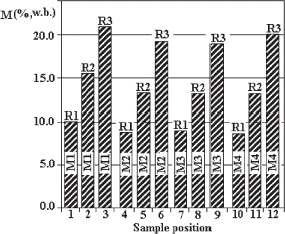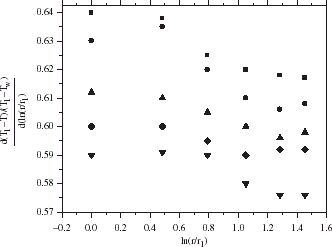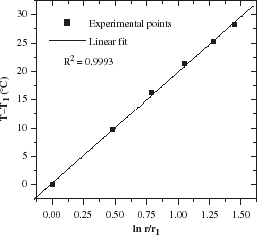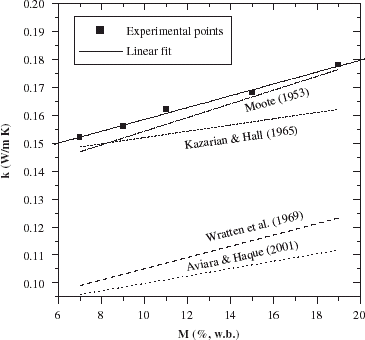Abstract
Steady-state concentric cylinder equipment was used to determine the effective thermal conductivity of beans (Phaseolus vulgaris). The measuring cell had no heated end guards and its length to diameter ratio was 10.5. Glass beads were employed to assess the accuracy and repeatability of the experimental system under heat transfer conditions. The results agree well with those reported in the literature so that the system can be considered reliable. Corn was used to verify the system's accuracy under heat and mass transfer conditions. Again the results were satisfactory. Moisture migration was observed and measured during the tests with beans, but this behavior does not compromise thermal conductivity values if both thermal and mass transfer steady-states are correctly interpreted. The effective thermal conductivity increases linearly with increasing grain moisture content. Statistical regression leads to good estimates of the fitted parameters.
Introduction
Grains are the major source of human food and their losses due to inadequate post-harvest procedures are high, varying from 10% to 25% of the total grain production.Citation1 To minimize these losses, correct knowledge of grain thermal properties is essential for the design and operation of thermal processes, and grain storage. Among other properties, the effective thermal conductivity (k) is crucial in steady and unsteady-state processes. Many studies have been published about this physical property, and good reviews regarding its experimental determination are found in Tye,Citation2 Reidy and Rippen,Citation3 Mohsenin,Citation4 Ohlsson,Citation5 and Okos.Citation6 In general, one may divide the experimental methods for determining thermal conductivity into steady-state and unsteady-state methods. Unsteady-state techniques are well represented by a probe based on the heat line source concept. This experimental method is widely employed for food stuffs, with its main advantages being quickness, small samples size, and low cost.Citation7 Citation8 Citation9 Citation10 Citation11 Citation12 The main disadvantages are the need for calibration, the fragility and difficulty in constructing the probe, and the laborious calculation procedure. PrattCitation13 stated that this probe is not suitable for coarse granular materials due to the high thermal contact resistance.
Steady-state methods may be divided into flat isotherm and radial isotherm methods. These methods demand long experimental times, especially for moist materials. Thus, many authorsCitation4 Citation5 Citation7 Citation10 Citation14 have noted the problem of moisture migration in these type of experiments, but only Moote showed evidence of this effect and discussed its possible influence on k. Equipment of this type needs no calibration and the calculation procedure is simple. A flat isotherm apparatus was used for foods by Drusas and Saravacos,Citation15 Drusas et al.,Citation16 and Aviara and Haque.Citation17 Its construction is more elaborate than the radial isotherm cell, but less complex than the unsteady-state probe. Generally, the flat isotherm method requires smaller quantities of sample than the radial isotherm method, as used for food materials by Babbitt,Citation18 Moote,Citation14 Ohja et al.,Citation19 and Dua and Ojha.Citation20
In this work, the radial isotherm method was used to assess the moisture migration intensity and its possible effect on the bulk thermal conductivity. Beans (Phaseolus vulgaris) were tested because this grain is heavily consumed in developing countries, and there is no work in the literature about its thermal conductivity. In Brazil, this leguminous plant is consumed by all social layers, providing most of the protein intake of poor populations. The crops are concentrated in small farms, so it also plays an important social role. Many different initial grain moistures were used in this study.
Materials and Methods
Glass beads and corn were used to assess the accuracy of the equipment. The glass beads were 3.1 mm in diameter and the corn (Zea mays) was a flint hybrid type, with a moisture content of 15% (wb). The beans (Phaseolus vulgaris) were a Pearl variety (Pérola, in Portuguese), grown and cooked in many regions of Brazil. The beans were previously separated into uniform size fractions, with the average diameter of the particles about 6.1 mm. Five different initial values of the grain moisture were used, varying from 7% to 19%. The initial moisture content was 15%. Higher moisture values were achieved by exposing the grains to a saturated steam atmosphere at 50°C. The lower values were obtained by drying in a forced convection oven at 50°C.
Basic centesimal composition of the grains, namely fat, protein, moisture, and ash, were determined by techniques recommended by AOAC.Citation21 The carbohydrate quantity was estimated by subtracting the sum of these constituents from 100%.
A measuring cell with a length (L) to diameter (D) ratio equal to 10.5 was constructed (Fig. ). According to McElroy and MooreCitation22 this ratio is sufficient to avoid significant thermal end effects, even when the cell is not provided with heated end guards. The main cell body was made of aluminum tube of inner diameter 0.095 m and wall thickness 3 mm. Four modules of 0.25 m length were connected, giving a 1.0 m long cell. A nylon screen was inserted between consecutive modules, to hold the pack in place. The upper and lower flanges were made with a 20 mm thick thermal insulating material (nylon). A 7.2 Ω Ni–Cr electrical resistance was housed in a copper tube of 0.015 m inner diameter, 1.0 mm wall thickness and 1.0 m length. A PVC tube of inner diameter 0.15 m surrounded the aluminum tube. The annular space between them was used as a water jacket, with water circulated from a thermostatic bath by a radial centrifugal pump. Six thermocouples probes, each 0.50 m long and 3 mm in outer diameter, were inserted axially in the cell with their tips at the centrepoint middle of the cell length. With the bed packed with beans of 15% moisture content, an electrical sensor was used to measure the air relativity humidity in order to assess the thermodynamic equilibrium between the grains and the surrounding air. This sensor, shown in Fig. , was positioned between the first and second modules, and its radial position varied from one experiment to another. All thermocouples were of T-type and were connected in a T-type switch, which was connected to a temperature indicator with decimal Celsius degree resolution.
The temperature of the water jacket was fixed at 25°C and the power supply was adjusted to provide constant dissipated power (18.4 W) to the bed. For the tests with beans, despite different grains moistures, the mean bed temperature remained nearly constant at 34.0°C±0.22°C.
The bed was packed employing the technique recommended by ZotinCitation23 for soft packings. This method consists of dropping a fixed quantity of particles from a fixed height to the same point inside the tube, close to the tube center. In this work we dropped 200 g of particles from a height of 250 mm each time until the tubes were completely filled.
After the experiments with beans, a device composed of three concentric cylinders, shown in Fig. , was inserted at the top of each module to evaluate the moisture migration inside the bed. These cylinders were made from 1 mm thick galvanized iron sheets, with the outermost cylinder touching the aluminum tube. The sharp edges of the cylinders penetrated about 20 mm into the grain bed and the grains were sampled from each annular region between adjacent cylinders, these regions being coincident with the positions of two temperature measurements and one air relative humidity measurement. Due to the restricted space, a small sample (≈30 g) was collected from each annular region. A total of 12 moisture determinations were made for each run (three radial positions at each four axial positions).
All tests for beans and corn were repeated. Twenty-one tests were carried out with glass beads in order to determine the probabilistic error distribution of k for this material and to assess the accuracy and precision of the experimental method.
The simple solution for steady-state heat transfer for cylindrical isotherm systems was used to calculate the thermal conductivity, that isCitation3 Citation6 Citation22
where T and r are the temperature and radial coordinate variables, P is the power dissipated by the electrical resistance, T 1 is a reference temperature, and r 1 the radial position where T 1 was measured. The mean cup temperature concept was used to determine the mean bed temperature. It was calculated by numerically integrating the experimental radial temperature profile with the aid of Simpson's rule.
To verify the mass transfer equilibrium between the grains and the air in the different radial regions, it was necessary to use both sorption and desorption isotherm equations. MattaCitation24 developed equations specifically for the same variety of beans as used in this work:
Bulk bed porosity (ε) was determined via its definition
Results and Discussion
Results for the centesimal composition analysis of beans and corn are presented in Table . Note the high content of protein in the beans. For the experiments with glass beads, steady-state was reached in about 4 h, while for the grains this time was much longer, about 72 h. It was assumed that the system had reached thermal steady-state when all temperatures given by all thermocouples remained constant judging from readings separated by one hour for the glass beads and six hours for the grains. The error distribution for the glass beads is well represented by a normal probability distribution, facilitating statistical inferences on the confidence interval over the mean value of k. The value obtained for k was 0.252 W/m K, with a confidence interval of ±0.003 W/m K. This value of k is within those found in the literature for this material.Citation25 Citation26 Citation27 Citation28 Thus, one may consider the results given by this equipment to be reliable and repeatable.
Table 1 Grains composition (wb)
As shown in Fig. , the moisture migration for beans was significant at the end of an experiment. The hot regions (R1=innermost internal radial region) presented lower moisture values than the cold regions (R3=outermost external radial region). No observable longitudinal moisture variation for any specific radial position was observed. With the humidity sensor in the innermost radial region (R1), close to the resistance, the relative humidity was 32.1%, with the mean temperature provided by the two thermocouples in that region was 49.1°C. Thus, the calculated desorption equilibrium moisture (DEM) was 7.4%, while the experimental DEM value was 7.7%. For the external radial region (R3) the relative humidity was 82.6%, and the mean temperature 29.9°C. The calculated sorption equilibrium moisture (SEM) was 18.8%, close to the experimental value of 19.3%. There was very good agreement between calculated and experimental results, indicating that there is a local thermodynamic equilibrium in each region analyzed. Thus, the system could be considered to be at steady-state, both thermally and in terms of mass transfer, and no more moisture migration would occur to influence k values. However, the thermal steady-state was not completely reached, since very a small and gradual temperature rise could occur after 72 hours, which, as previously mentioned, was initially considered sufficient to reach steady-state.
Figure 2. Moisture distribution after the experiment for beans (initial moisture 14.7%, M1–M4 and R1–R3, refer to Fig. ).

Figure presents typical experimental results for beans. The points are well represented by a straight line with a high regression coefficient (R 2). However, when the slope of that curve is plotted against the logarithm of the non-dimensional radial position as in Fig. , the expected result, a straight line parallel to the x-axis, does not occur. This was pointed out by MooteCitation14 and indicates that the system has not achieved steady-state. However, as observed by Moote, on the right side of Fig. the three temperature data points have nearly the same ordinate values, indicating that these points nearest to the tube wall are nearly at steady-state. If all six temperature data points measured along the entire cross section of the bed were used to calculate k, no clear trend with grain moisture content would be observed. On the other hand, using only the three aligned temperature data points, k values increased linearly with increasing grain moisture as shown in Fig. . This linear trend of k with increasing grain moisture was previously pointed out by several authors for distinct grains.Citation7 Citation8 Citation9 Citation17 Citation29 Although MooteCitation14 observed similar behavior, her measurement cell had a very short L/D ratio (≈2), suggesting that thermal end effects likely occurred. Moote claimed that the steady-state was reached only after 100 hours of operation when wheat of 15% moisture content was used, but demonstrated that the k values obtained with only the aligned temperature points are very close to the steady-state values.
Figure 4. Slope from linear fits for beans (moisture content: ▾, 7%; ♦, 9%; ▴, 11%; •, 15%; ▪, 19%).

Linear regression analysis for k, based solely on the aligned points, was carried out using an equation of the form
Coefficients A and B are presented in the Table with their respective standard deviations (S).
Table 2 Parameters and statistics for Eq. (Equation4)
Table , also provides the relative deviation (RD) obtained by dividing S by the actual parameter value, and the t-student statistics value with three degrees of freedom and 95% confidence. If RD is lower than the t-student value, the parameter estimate may be considered to lit within the 95% confidence limit. Thus, both parameters estimated in this work are accepted at this level of confidence.
Applying the same technique to corn grains, the experimental value of k was 0.162 W/m K for 15% moisture content. Based on the equation of Kazarian and Hall,Citation7 the calculated k value is 0.158 W/m K, in good agreement with the experimental value considering that these authors used both a different variety of corn and a different experimental technique. Again this helps to validate the results presented for beans.
Conclusions
Steady-state concentric cylinder equipment was employed to investigate the thermal conductivity of food grains. This gave reliable values of this important physical property, despite the occurrence of moisture migration throughout the bed of grains. The experimental results with glass beads and corn grains at 15% moisture content (wb) showed good agreement with values reported in the literature. The experimental operating time was relatively long and the grain sample large, but both the simple calculation procedure and the simple experimental set-up make this equipment useful for these experiments.
The thermal conductivity of beans (Phaseolus vulgaris), Pearl variety, increased linearly with increasing grain moisture content when only the experimental temperature data points close to the bed wall were used to calculate this property. The linear coefficient (A) is equal to 0.1373, while the angular coefficient (B) was 0.00212. If all points were used to calculate k, no definite tendency regarding the variation of thermal conductivity with increasing grain moisture could be observed.
Acknowledgments
The authors are grateful to FAPESP and CNPq (PRONEX) for financial support, and to Mr. J. J. De Milio and Mr. Arturo Macchi for their valuable contributions.
References
- Bala , B.K. 1997 . Drying and Storage of Cereal Grains Enfield : Science Pub .
- Tye , R.P. 1969 . Thermal Conductivity London : Academic Press .
- Reidy , G.A. and Rippen , A.L. 1971 . Methods for determining thermal conductivity of foods . Trans. ASAE , 14 : 248 – 254 .
- Mohsenin , N.N. 1980 . Thermal Properties of Foods and Agricultural Materials New York : Gordon and Breach .
- Ohlsson , T. 1983 . “ The measurement of thermal properties ” . In In Physical Properties of Foods Edited by: Jowitt , R. Essex : Elsevier Applied Science . Chap. 17
- Okos , M.R. 1986 . Physical and Chemical Properties of Food Michigan : ASAE .
- Kazarian , E.A. and Hall , C.W. 1965 . Thermal properties of grain . Trans. ASAE , 8 : 33 – 48 .
- Sharma , D.K. and Thompson , T.L. 1973 . Heat and thermal conductivity of sorghum . Trans. ASAE , 16 : 114 – 117 .
- Moyse , E.B. , Shaw , J.T. and Lampman , W.P. 1977 . The effects of temperature and moisture on the thermal properties of rapeseed . Trans. ASAE , 20 : 461 – 464 .
- Sweat , V.E. 1995 . “ Thermal properties of foods ” . In Engineering Properties of Foods Edited by: Rao , M.A. and Rizvi , S.S.H. New York : Marcel Dekker . Chap. 3
- Singh , K.K. and Goswami , T.K. 2000 . Thermal properties of cumin seed . J. Food Eng. , 45 : 181 – 187 . [CROSSREF]
- Elustondo , D. , Elustondo , M.P. and Urbicain , M.J. 2001 . New thermal conductivity probe design based on the analysis of error sources . J. Food Eng. , 48 : 325 – 333 . [CROSSREF]
- Pratt , A.W. 1969 . “ Heat transmission in low conductivity materials ” . In Thermal Conductivity Edited by: Tye , P. London : Academic Press . Chap. 8
- Moote , I. 1953 . The effect of moisture on the thermal properties of wheat . Can. J. Technol. , 31 : 57 – 69 .
- Drusas , A.E. and Saravacos , G.D. 1985 . Thermal conductivity of tomato paste . J. Food Eng. , 4 : 157 – 168 . [CROSSREF]
- Drusas , A. , Tassopoulus , M. and Saravacos , G.D. 1986 . “ Thermal conductivity of starch gels ” . In Food Engineering and Process Applications. Volume 1: Transport Phenomena Edited by: Le Maguer , M. and Jelen , P. Essex : Elsevier Applied Science . Chap. 13
- Aviara , N.A. and Haque , M.A. 2001 . Moisture dependence of thermal properties of sheanut kernel . J. Food Eng. , 47 : 109 – 113 . [CROSSREF]
- Babbitt , J.D. 1945 . The thermal properties of wheat in bulk . Can. J. Res. , 23 : 388 – 401 .
- Ohja , T.P. , Farall , A.W. , Dhanak , A.M. and Stine , C.M. 1967 . A method of determining heat transfer through powdered food products . Trans. ASAE , 10 : 543 – 544 .
- Dua , K.K. and Ojha , T.P. 1969 . Measurement of thermal conductivity of paddy grain and its by-products . J. Agr. Eng. Res. , 14 : 11 – 17 . [CROSSREF]
- AOAC. 1980 . Official Methods of Analysis, , 13th Ed. Washington, D.C. : Association of Official Analytical Chemists .
- McElroy , D.L. and Moore , J.P. 1969 . “ Radial heat flow methods for the measurement of the thermal conductivity of solids ” . In Thermal Conductivity Edited by: Tye , R.P. London : Academic Press . Chap. 6
- Zotin , F.M.Z. 1985 . The Wall Effect on Packed Columns São Carlos : Federal University of São Carlos . MSc Thesis (in Portuguese)
- Matta , M.E.R.M.C. 1997 . Short Time–High Temperature Drying Effects Over Storaging of Beans (Phaseolus vulgaris L.) Seeds in Shallow Beds Campinas : Campinas State University . DSc Thesis (in Portuguese)
- Ofuchi , K.O. and Kunii , D. 1965 . Heat transfer characteristics of packed beds with stagnant fluids . Int. J. Heat Mass Transfer , 8 : 749 – 757 . [CROSSREF]
- Wechsler , A. 1968 . Glass beads: a standard for the low thermal conductivity range. National Bureau of Standards . special publication 302 , : 89 – 96 .
- Freire , J.T. 1979 . Heat Transfer in Porous Media Rio de Janeiro : Federal University of Rio de Janeiro . DSc Thesis (in Portuguese)
- Kent , M , Christiansen , K. , van Haneghen , I.A. , Holtz , E. , Morley , M.J. , Nesvabda , P. and Poulsen , K.P. 1984 . Cost 90 Collaborative measurements of thermal properties of foods . J. Food Eng. , 3 : 117 – 150 . [CROSSREF]
- Wratten , F.T. , Poole , W.D. , Chesness , J.L. , Bal , S. and Ramarao , V. 1969 . Physical and thermal properties of rough rice . Trans. ASAE , 12 : 801 – 803 .


